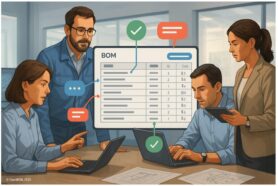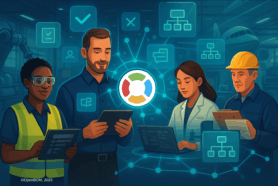
Imagine bringing someone who was driving a manual stick shift transmission and putting that person in a modern car with automatic transmission. I imagine the immediate question that person will ask is, where is the clutch? According to the U.S. Environmental Protection Agency, 35% of cars for sale in the U.S. had manual transmissions in 1980, but by 2021 it was down to approximately 1%. And only 18% of American drivers can even handle a stick, says U.S. News and Report.
Automatic Transmission Transformation – Technology & Business
The history of automatic transmission was very interesting and goes back much longer than you can think. The first automatic transmission was patented in 1923. Alfred Horner Munro, a Canadian steam engineer, designed the first automatic transmission in 1921 and patented the transmission in 1923. He created the automatic transmission with four forward gears and no reverse or parking gears, and he used air pressure instead of hydraulic fluid.
The first car with a commercially available automatic transmission was Oldsmobile 1948. Read more here. General Motors developed the first hydraulic fluid automatic transmission, which was introduced in 1940 as the original “Hydra-Matic.” This transmission was an important innovation, not only because it was really working, but also because of the timing of the innovation that triggered a commercial’s success and paved the way for every subsequent auto shifter.
The technology came along at an opportune time in history as North America was abundant with victory from World War II and building up steam for the post-war boom. Scads of babies and cars were produced (not necessarily in that order). Into those cars they dropped thousands of automatic transmissions. With its simplicity and ease of use, the automatic transmission offered up the automobile to the masses, fulfilling the promise of President Hoover, whom a generation earlier had promised “a car in every garage and a chicken in every pot.”
Let’s now shift gears and talk about PDM, PLM and digital transformation. We live at the intersection of multiple paradigms. Every day I look around and I can see how new paradigms are changing old paradigms.
Digital Collaboration and Breaking Existing Paradigms
Looking at the history of CAD, PDM, and PLM development, I can see a lot of similarities related to the paradigm shifts. First, CAD systems were born into a File paradigm reality, which was driving the popularity of CAD systems using files as portability of data and transferring it from one place to another place. Introducing the first PDM system was the result of the necessity to control access and the history of changes. The next 30 years after were one big struggle of technology to shift from popular and ubiquitous file paradigms to find a better way to auto-shift people and companies to manage files (and better data) in a way that allows multiple people to work together but at the same time, don’t break existing CAD file management systems. A similar story happened with PLM and other data management systems that fundamentally were designed to protect data instead of allowing people to collaborate and work together.
Web 2.0 and other collaborative tools were born to allow people to collaborate and use web platforms as an information layer that delivers seamless information sharing, exchange, and collaboration – websites with dynamic content, social networking with commenting, chats, and collaboration, and finally, collaborative systems allowing users to edit data simultaneously created a paradigm switch that expanded to change the way old fashion CAD, PDM and PLM systems work.
OpenBOM Collaboration – BOMs and Files
The vision of OpenBOM was to create a platform that gives their users the ability to manage data and collaborate between users regardless of the location, company, and data. The vision of seamless and simultaneous collaboration is the foundation of OpenBOM technology and it starts from BOM collaboration with the ability of multiple users to edit product structure simultaneously by bringing information from multiple users and data sources (eg. CAD systems). OpenBOM patented collaborative BOM allows you to share data granularly and lets different people edit this information simultaneously. We expanded OpenBOM collaboration by introducing the Drive service that provides a way to share a virtual drive with files and edit information simultaneously using automatic and manual locking mechanisms with real-time updates.
Changing BOM Revision Paradigm
OpenBOM brings a new collaborative approach to the Item/BOM revision mechanism and BOM editing. Check the OpenBOM revision and lifecycle diagram below. The foundation layer is the “latest” state where users can freely collaborate and make simultaneous changes. Once the BOM is reaching the desired maturity level, the revision can capture this state (with or without the approval mechanism).
Changing PDM and File Management Paradigm
OpenBOM Drive changes the paradigm of PDM by setting a virtual disk that allows everyone to share data and to support the mechanism of locking, allowing everyone to protect the data when making changes and seamlessly making all updates available to all members of the team. Unlike traditional PDM, such an approach eliminates the need for periodical “sync check-in” bringing all files from local workspaces to the central Vault.
Conclusion:
I like to compare OpenBOM data management and collaboration with automatic transmission in cars. Instead of separating data between people and managing silos, OpenBOM creates mechanisms that help people to work together without being afraid to break things. It started with BOM collaborative and revision management with the “latest” state and revision snapshots allowing multiple users to edit data in the latest state and release the data by saving revisions (with collaborative approval workflow). OpenBOM Drive brings a new paradigm to PDM services by eliminating the need to copy files manually using Check-out/in mechanism and automating the entire process allowing users to work collaboratively and get instant file updates coming from multiple people.
Altogether, it is a paradigm shift, which will allow you to work differently, but will demand some “mind shifting”. But here is why it is a great time to do it – digital transformation is here. Companies are looking at how to replace their legacy systems and data management paradigms to switch from decades-old PDM/PLM systems to modern cloud-native services.
REGISTER FOR FREE and start a 14-day trial to experience OpenBOM data management and collaboration today.
Best, Oleg
Join our newsletter to receive a weekly portion of news, articles, and tips about OpenBOM and our community.










